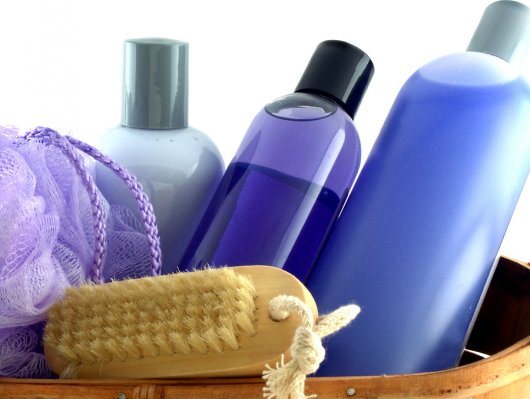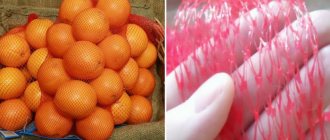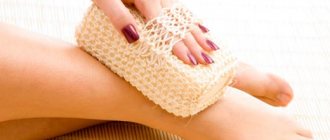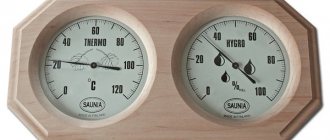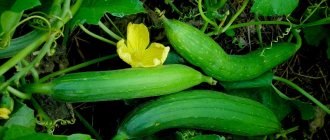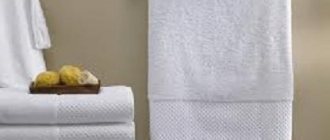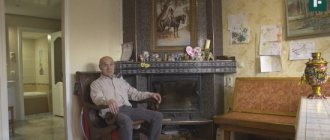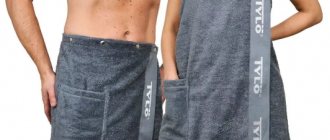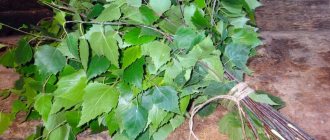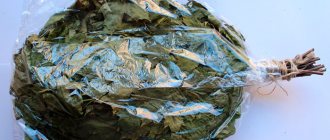Resistant to water.
Many folk dolls are made from moss. They say that large paint brushes made from bast are sometimes sold in construction stores, but I have never seen them. Make the sponge yourself - it’s a pity for the linden tree only if you’re lucky enough to find the fallen one, but so far you haven’t come across it.
Bast can be bought in brushes - it can be used not only as a brush, but also for crafts; bast in brushes is of excellent quality.
Bast is not only good for dolls, it is also a real washcloth, for baths and more, it is also perfect for an ordinary city bath.
When steamed, linden bast becomes soft and silky, just like the skin after peeling with a bast washcloth. When using a washcloth, bast fibers release phytoncides
- the best remedy for the prevention of colds.
Bast washcloths are made from the inner layer of linden bark, split and specially processed. After steaming, linden bast becomes soft and helps to perfectly cleanse the skin, this is explained by the fact that the entire surface of the bast is covered with tiny fibers. Among the body washcloths, there is another wonderful natural material - they are also suitable for creating crafts, like the loofah.
The thickness of the villi is comparable to the size of human pores, therefore, when we wash ourselves with bast washcloth, it not only scrubs and massages, but also cleanses the pores. In addition, during washing, fibers release phytoncides, which, as you know, are the best weapon against microbes. Such a washcloth will ensure cleanliness, will not harm the skin, and will also help protect against colds.
A bast is a mandatory attribute of a Russian bath. Removes static electricity, improves skin regeneration. When using the washcloth, you first need to steam it with boiling water for 10 minutes, then pour it over with cold water and soap it.
The tradition of making bast bast came to us from time immemorial. Bast sponge was used not only for washing, it has always served as an excellent addition to a bath broom as a tool for massage.
Once upon a time the linden tree covered almost all of Rus'. Bast fibers from linden bark were used to make bast shoes, feet, shoe covers, boots and sandals. One shoe was worn during long journeys, another during commercial hunting and fishing, and the third was simply used as house shoes, similar to modern slippers. For Russian people, wicker bast shoes were as traditional as wooden shoes for the peasants of Western Europe.
Bast for weaving shoes was removed from trees no older than ten years old. After making longitudinal cuts on the trunk with a knife, the harvesters removed four narrow strips from each tree. After removing the top crust, the bast ribbons were soaked and weaving began.
Linden wood has a unique smell, this smell is persistent and lasts for many years.
It smells nice of loofah and maybe a little linden blossom.
Everyone knows the little rhyme about the “white hare” who picked a bast in the forest and put it under a log. In fact, the hare does not prepare bast, but simply feasts on the sweet and juicy bark.
But squirrels, crows and rooks actually harvest bast. They pluck it from dried branches without causing any harm to the tree. The dry crust covering the bast fibers crumbles, but the flexible soft fibers remain. This is what squirrels and birds line their nests with.
Durable bast fibers of old and young linden trees have found a wide variety of uses in human economic activities. For basting, the bark was removed from large trees. Longitudinal cuts were made on the trunk on both sides. Then, using a wooden wedge, two half-cylinder grooves were separated from the trunk. The bark removed in this way was called bast. Dried bast was used as roofing material for outbuildings, and simple utensils for dry food were made from it. But the main part of the bast was used for the production of bast, the use of which was very diverse. To obtain bast, bast was soaked in mochila - ditches dug in the forest near a stream or lake. Bast harvested in spring or early summer was loaded into soaking ditches. Well-soaked bast was hung out to dry, and in winter it was brought to the village and put into use.
Soaked bast fibers tied into a bundle instantly turned into a bath sponge, which is well known to modern people. They knitted brushes from bast for whitewashing stoves, made brushes and brushes for washing dishes, wove quite strong ropes and even threads for fishing nets. Archaeological excavations confirm that fishing nets were woven from bast back in the Neolithic era. The strength of ropes made from moss can be judged by the fact that they were used to make harnesses and fetters for horses. On simple wooden looms, village craftsmen wove matting, from which they made coolies, capes for horses, and much more. The ancient Germans wove clothes from bast - mainly cloaks and belts. In Russia in the last century, Ryazan lamplighters made raincoats from bast bags. One corner of the sack-bag was inserted into the other - and the cloak was ready. In the old days, sponge was widely used by carpenters as padding material for upholstered furniture.
The mop was also used for polishing wooden furniture. Moreover, it was used so widely that the polishing process itself began to be called basting.
Oil, caviar and grape juice are well preserved in linden containers. In the Caucasus, huge vats for squeezing grape juice and churns were made from linden trees. In modern cooperage, linden staves are used to make dishes intended for storing and transporting granular caviar.
There is a village in Russia where people live in a rare ancient profession - washers.
I stand on the slippery platform and try not to inhale deeply: it smells like rotting wood. “Just don’t fall,” I think, and, as if on purpose, at that very second I lose my balance and find myself in muddy water. Fortunately, this is a very shallow pond - the locals call it mochische. Alexey, a man of about thirty-five, helps me get out, but he himself remains waist-deep in the water. He takes out bundles of tree bark, submerged under the weight, from the pond, and then spreads them on the ground, like carpets. Photographer Marina Makovetskaya records Alexey's every move. Marina and I are in the Nizhny Novgorod region - in the village of Bukaley with a population of 43 people. Alexey shows us how he earns a living for his family. Here he is, with his hands, tearing off the inner layer of the “carpets” - white wood fibers - and hanging them on the fences to dry. What is he doing? A century ago, any of our compatriots would have immediately answered this question. The Bukaleyans are one of the last people who live by the oldest Russian craft - mocha.
“For the sled, you need to tear out two fir trees with roots bent like hooks, tie them and lay bark on them,” says the tutorial for spongers. The author of the manual does not specify how the peasants pulled out the Christmas trees.
The Chinese had silk, the British had wool, and the Russians had bast.
This material played such an important role in the fate of Russia that, without exaggeration, it could be considered a national symbol on a par with sable fur. But they forgot about the sponge as soon as the need for it disappeared. Today even the meaning of this word is not known to everyone in Russia. Bast was the name given to the inner part of the linden bark soaked in water and dried - bast (also known as bast, or subbark). From it, peasants on an industrial scale made dozens of necessary things: bast shoes, sea ropes, brushes for whitewashing, bath sponges (now it’s clear why they are called that), roofing for the roof, sieves for flour and matting - cheap fabric that was used for clothing and bags. Matting, as the most popular product, was partially exported. Until the beginning of the 20th century, linden bark “fed” at least half of the peasants in Central Russia - mainly residents of the northern Volga region. According to the census of the Imperial Forestry Institute, in 1912 alone, 2.8 million poods were harvested, that is, 44 thousand tons of bast. In Russia it was an irreplaceable material - the same as PVC or polyethylene today. If it were not for the urinary industry, the residents of the village of Bukaley would be faced with a real subsistence economy: they already eat mainly their own products - meat and vegetables, eggs and milk.
Photo: “Fishing”, “karabat”, “combing”, “knitting” - not just words from Dahl’s Explanatory Dictionary - these are stages of the production process of making bast washcloths and brushes in Bukaleya. Author: Marina Makovetskaya">
“Fishing”, “karabat”, “combing”, “knitting” - not just words from Dahl’s Explanatory Dictionary - these are stages of the production process of making bast washcloths and brushes in Bukaleya.
People who made their living by preparing bast were called bast workers. In 1840, geographer Peter Keppen counted hundreds of thousands of peasants making bast in only eight Volga provinces. The scale of the fishery was so enormous that, concerned about the condition of the linden forests, the Ministry of State Property sent Köppen on a two-year expedition to calculate the damage. “In the forests of Russia there are many lindens, on the extermination of which one of the most remarkable industries is based,” the geographer wrote. “Knowing that this fishery, so national, has not yet been described by anyone, I decided to collect information about it.” The information presented by Köppen in the 60-page report “On the bast industry” is unique: for example, only he has information that in the Crimea bast was made from date tree fibers.
Marina Makovetskaya found out about the village of mokalniks when she was filming for another article in the village of Polkh-Maidan, neighboring Bukaley, where nesting dolls are made from linden trees: then they explained to Marina that the Bukaley residents take the bark for themselves. “Mutually beneficial cooperation has been established in the two villages,” the photographer said when she arrived at the editorial office. “The linden makers have no problems with raw materials, and it’s convenient for the nesting doll makers: the neighbors peel the bark from the linden trees for free.” Without thinking twice, we headed to the Nizhny Novgorod region, armed with Köppen’s book and the self-instruction manual “How to Prepare Bast”, 1912 edition. In the preface, the author - a certain Permyak - assured that anyone can master an “easy and profitable craft”. But from the first pages it became obvious that urination was a very extreme activity. The most dangerous stage of the wet business
there was a harvest of linden bark. Whole families of peasants left to chop and “pluck linden trees” at the beginning of May: at this time, sap begins to move in the trees, and the bark more easily separates from the wood. The mokalniks, along with their wives and children, lived in the swampy forests for several weeks. The bark of young linden trees was torn off with teeth, according to Köppen, into bast shoes; large trees were felled and peeled with an ax. Sometimes, for the sake of speed, the bark was removed directly from standing trees. In such cases, lykoders climbed the tree without a ladder - with the help of ropes from the same bast. While the forest was being cut down, horses often died, and people died due to dampness and disease. In 1913, Nikolai Filippov, a professor at the Imperial Forestry Institute, called the working conditions of washmen “inhumane and harsh.” However, Peter Keppen wrote about the difficulties of the basting industry with laconic severity: “All this is natural and does not serve as a reason for complaints.” Today in Bukalei, the difficulties of extracting bark have been reduced to almost zero: the bark is stripped off in Polkh-Maidan from already cut down trees. The Bukaleyans could not work in the forest even if they wanted to: almost all the villagers are single women over sixty. There are only two young families in the village. Nina Belova, a pharmacist from Nizhny Novgorod, who long ago left Bukaley to study, helped us get to know the local residents. Nina remembers well how, as a child, she “scratched” the washcloth at night - she helped her mother with work in the artel. According to Belova, in Bukaleya the majority are engaged in urination due to a habit that has been ingrained among people since ancient times. “There used to be an artel in the village. They wove matting from bast, made bags and mattresses from it; there is still a matting machine in every house, I’ll show you,” says our escort on the way to the village.
For those who do not want or cannot study after school, this lifestyle is better than migrant workers in Moscow. You create something from scrap materials, benefit people and preserve the tradition of your ancestors.
We enter the main and only street of Bukaleya: cows are walking along it, but not a soul is visible. Nina jokingly reminds that the name of the village is translated from Chuvash as “valley of bulls.” At first glance at the ancient houses, it is clear that Bukaley is a place where people live in the past, almost cut off from modern civilization. A bus from the regional center comes here once a day, and a grocery store comes here every three days. There is no electricity or running water in the village. We go to the first house - one of the oldest residents of Bukaleya, Evdokia Fedorovna Klimakova, lives here. In the yard I stop for a second: a very strong specific aroma hits my nose - something between the smells of a kennel, rotten eggs and linden flowers. Evdokia Fedorovna, like all the residents of Bukaley, no longer feels this smell - her clothes smell even stronger. The aroma thickens as we approach the barn with the ingredients. As soon as we enter inside, we understand: there is nowhere to go further - the high room is filled to the ceiling with rotting bast and linden bark. “I don’t have time to work,” explains the owner. The Bukaleans produce two types of products from sponge
– paint brushes and bath sponges. There are no individual entrepreneurs in the village - women, in the old fashioned way, without any bills or invoices, sell brushes and washcloths to resellers. “People come from Rostov to buy brushes; they are sold in Ukraine,” says Evdokia Fedorovna. “And washcloths are bought from different places, sometimes for beauty salons.” An unexpected phrase in the mouth of an eighty-year-old woman from a remote village, but she knows what she’s talking about: resellers really sell fake washcloths - at a high price, by the way - in elite spa salons. Evdokia Fedorovna has difficulty walking, but deftly snatches a piece from the mountain of undergrowth and shows what it means to scratch a bast. Fifteen times she runs the washcloth along a comb of nails nailed to the floor, and in a few seconds twists the resulting fibers into a figure-of-eight knot. The real Russian washcloth is ready.
Photo: A brush from the Russian hinterland whitewashes a Ukrainian hut - the product has reached the consumer. According to a long-standing tradition, houses in Ukraine are renovated in the spring before Easter. Over the year, the price of a bast brush has doubled: 50 hryvnia (140 rubles) versus 25. Author: Marina Makovetskaya">
A brush from the Russian hinterland whitewashes a Ukrainian hut - the product has reached the consumer. According to a long-standing tradition, houses in Ukraine are renovated in the spring before Easter. Over the year, the price of a bast brush has doubled: 50 hryvnia (140 rubles) versus 25.
Photo: Tatyana Fedorovna Klimakova is called “factory” by her fellow villagers. Since childhood, she has been accustomed to “scratching” brushes - at least twenty a day. This was the norm set by the parents. And now, despite her age and gardening and land work, the woman works every day in the workshop - and so on all year, except for major holidays. Author: Marina Makovetskaya">
Tatyana Fedorovna Klimakova is called “factory” by her fellow villagers. Since childhood, she has been accustomed to “scratching” brushes - at least twenty a day. This was the norm set by the parents. And now, despite her age and gardening and land work, the woman works every day in the workshop - and so on all year, except for major holidays.
“How do you select bark for raw materials?” - I ask. “No way, everything comes into play indiscriminately. We use dark washcloth for brushes, white for washcloths,” the woman answers. A century ago, this technology did not work. The peasants chose the best linden tree in advance, even before the onset of spring. “In winter, in his free time, the urchin should look for places in the wilderness where linden grows better, so that in the spring he does not needlessly get lost in the forest,” the tutorial gives clear instructions. The best was considered a middle-aged linden with a diameter of 5 vershok (a little more than 20 centimeters), growing on sandy soil in a spruce or fir forest. The author of the best-selling book How to Harvest Bast explains: “Bat taken from a tree growing in good sandy soil weighs more. Bast is difficult to separate from old trees, and its color is dark.” The bark leaves were collected into bundles (rocks), and everything was ready for the second stage of harvesting - soaking. To look at the lock of the linden bark
, Nina and I are heading to Lena and Alexey’s family - in Bukaleya everyone has their own urine. Unlike other, older villagers, this couple produces bast in large quantities. Even Lena and Alexei’s daughter, second grader Ira, is involved in the family business. Immediately after the spring harvest, the linden bark is soaked and left in water until autumn, so that the bast becomes soft and easily separates from the outer bark. Fortunately, modern washers don't have to think about delivering the bark to the washbasins. Previously, transporting raw materials to a river or dam was fraught with many problems. Carts got stuck in swampy forests, and peasants had to come up with creative ways to transport heavy loads. The self-instruction manual for scourers described an extravagant technique that cannot be ignored: making “quick” sleds from spruce. “For the sled, you need to tear out two Christmas trees with roots bent like hooks, tie them and lay bark on them,” the book teaches. The author of the manual does not specify how the peasants pulled out the Christmas trees. But somehow we managed - the mother of our guide Nina Belova, who quit fishing just a few years ago due to health problems, remembers that her grandfather made similar sleds.
We knock on the door of Lena and Alexei’s house, and fifteen minutes later the gates are opened for us. We pass through the yard, the backyard, the vegetable garden and, finally, we find ourselves in front of a wet spot that resembles a pond from the painting “Alyonushka”. (I couldn’t even imagine that in a few minutes I would find myself in it.) The already familiar smell from Evdokia Fedorovna’s barn reaches its climax here. Along the moische there are rows of hangers - wooden hangers for drying moss. The family prepares raw materials all summer: this year’s bark remains in the water until autumn, and in the meantime Alexey takes last year’s bark out of the water. “Why are you doing bast work? You are young people, you have not worked in an artel. Have you ever wanted to do something more modern?” – I ask Elena. “I got married in Bukaley, I do the same thing as my husband,” the woman answers very briefly and without emotion. My interest seems strange to her. “What’s unusual here?” – that’s all she says. According to Alexey, it is profitable to work with bast. This allows you to work only five months a year, and in winter you can find work in the city. The residents of Bukaleya got their own personal water ten years ago, when oil workers working near the village dug ponds for the residents as payment for their stay. Previously, the bark was soaked in rivers or streams in the forest - the same place where it was stripped. Sometimes one stream was dammed every ten meters. The bast needs standing water, a dam, and there are two reasons for this. Firstly, in this case the bast will definitely not be carried away by the current. Secondly, explains the self-instruction manual for bast cloths, “so that the bast does not turn black from the air.” In the fall, the bark is removed from the water and the underbark is separated. Previously, for this purpose in Bukaley they used a Russian instrument with a funny name - kochedyk (it is also called a bast awl - without a kochedyk you can’t weave bast shoes). But over time, all the Kochedyks in the village became lost, and finding new ones in modern Russia turned out to be difficult. To this day, people in Bukaleya tell how, back in Soviet times, several village craftsmen went to GUM to buy kochedyk, but did not find anything like it there and were very upset. Now Alexey can do it without a tool: he separates the sponge with his hands, digging his nails into the bark. “With your hand you can better feel the layer where the subcortex separates from the cortex,” he explains.
A very strong specific aroma hits your nose - something between the smells of a kennel, rotten eggs and linden flowers. It thickens as we approach the barn with the ingredients. As soon as we enter inside, we understand: there is nowhere to go further - the high room is filled to the ceiling with rotting bast and linden bark.
Evdokia Fedorovna gets more than a pound of raw materials from one linden tree. (In Bukaleya they still use this measure of weight - another piece of the past that has become the present here.) In the house of Evdokia Fedorovna’s sister, Tatyana, the bast is weighed on real pound scales from 1903. Two craftsmen in Bukaleya are still weaving bast shoes - but they do it not regularly, but “whenever they want.” According to bast masters, their products are also, although infrequently, purchased for spa salons - bast shoes are used there as massage slippers. But compared to brushes and washcloths, bast shoes are in less demand. Bastard became a large-scale fishery only in Russia
, despite the fact that the “raw material” – cordate linden – grows throughout Europe. Why this happened - neither ethnographers nor cultural scientists can give an exact answer. But environmentalists have some interesting comments. In 2012, employees of the Institute of Forestry of the Russian Academy of Sciences found that the disappearance of the lykoder craft has at least one huge advantage: after centuries of brutal felling, linden in Russia has finally restored its habitat over the past 70 years. The heart-shaped linden, Tilia cordata, has become an object of national basting fishery due to the specific structure of the trunk. All trees have bast, a sap-conducting tissue between the bark and wood. But it is the linden tree that has the thickest, most durable and softest bast. Especially a lot of linden bast was used to prepare bast shoes - very young trees were cut down for them. According to Koeppen, bast shoes made of birch bark and elm were uncomfortable and quickly turned black. But even without bast shoes, for one matting brush, 5 million linden trees were cut down in 1912 alone! It is no coincidence that Koeppen proposed expanding the production of various types of fabric and shoes instead of matting and bast shoes. And even earlier, in the 18th century, attempts were made to grow linden in Russia. “Linden is one of the main tree species in Russia, but if the linden fishery had continued for another century on such a scale, the tree would have risked becoming an endangered species,” wrote the prominent forest scientist Lev Rysin several years ago.
Today, it is not the linden tree that is threatened with extinction, but the craft. Tatyana Fedorovna remembers with gratitude even the seemingly recent Soviet times, when there was a stable demand for linden bast. “In our region, every schoolchild going to camp had to have a washcloth with him. In the summer we sold them for the whole year,” says the woman. Nobody talks about the future in Bukaleya - it seems indecent to ask questions on this topic here. Older women remember the past, while young families prefer to live in the present. “If necessary, we will move,” says Elena. On the way back from Bukaley, Nina Belova convinces us that bast is a very profitable occupation for her fellow countrymen: “There is a demand for bast, and no one would bother with bast if it did not pay off with interest.” Our guide thinks for a few minutes and continues: “For those who do not want or cannot study after school, this way of life is better than migrant workers in Moscow. You create something from scrap materials, bring benefits to people and preserve the tradition of your ancestors.” For the hundredth time these days, lines from childhood flash through my head: “There was a stake in the yard, on the stake there was a washcloth; start over!” Now I understand their meaning and significance.
I was sure that I had never used or washed a natural bast washcloth. Imagine my surprise when my mother dispelled my beliefs. It was with a bast washcloth that I was washed as a child; this shapeless tow was used for washing in our black bathhouse...
A disheveled bunch of an incomprehensible light brown color, spreading in different directions - this is a real bast washcloth!
In ancient times, people did not stand on ceremony with bath accessories. We didn’t choose everything in the same color scheme, we didn’t choose gentle washcloths, we didn’t look for fragrant soft soap, the shampoos were the simplest.
Bast is the inner fibrous side of the linden bark, that is, its fragile subcortical part.
The top layer of linden bark is peeled off and the resulting thin light material is cut into thin strips, from which a natural bath attribute is obtained.
But not only linden bast is used to make washcloths. You can use the bast of any young deciduous tree for the loofah.
We crochet a round washcloth in a step-by-step master class with diagrams
Since ancient times, people have resorted to various objects to take care of themselves that could replace a washcloth: tufts of grass, mosses, pebbles. Today, the developed trade industry offers a huge variety of washcloths, all kinds, shapes, colors. But at the same time, nothing prevents any family from having homemade knitted individual washcloths for each family member. After all, homemade products can take into account a person’s individual preferences in the hardness, shape, length and color of the washcloth. To knit a washcloth you only need a hook, thread and a little time. In this article we will look at several simple models of washcloths that anyone can knit if desired.
You should not use acrylic or wool yarn to knit washcloths. It is better to take threads made from natural materials such as twine, sisal, and linen threads. And for knitting waterproof and brightly colored items, the most common material is considered to be artificial polypropylene thread. The color scheme depends on the tastes and preferences of the needlewoman and who the washcloth is intended for.
When knitting, it is advisable to achieve loose knitting, since then the washcloth will be softer, more flexible and lathers well. You can tie a bulky washcloth and put a piece of soap and foam rubber inside. Then it will be convenient to use.
When knitting, it is better to choose a hook No. 5-No. 7, since a thinner tool will produce a denser and stiffer product.
Using this pattern, experienced knitters can easily make a round washcloth.
And for those who need more detailed instructions, this example of knitting round washcloths is offered.
- First, we cast on 6 air loops. We close it into a ring. We knit the next row with double crochets - 12 stitches. To make the washcloth fluffy, you can knit one regular stitch, and the next with an elongated loop.
- Third round: double crochet - two from each loop.
- Fourth round: knit without increments.
- We knit the following circles, alternating knitting: 1 row *double crochet*, 2nd row *single crochet*. Thanks to this knitting, the product will turn out flat and round, and will not bend.
- Penultimate round: From one loop, make two double crochets. From the next loop, knit only one stitch.
- Last round: knitted by alternating two double crochets from one base and two chain stitches.
- We tie and tie the handle.
It turns out to be such a washcloth.
Washcloths made from natural materials
Weaving washcloths for baths can be made not only from ready-made threads. Common nettle produces strong natural fibers that are used to make washcloths.
Young shoots are not suitable, but last year's stems are ideal. They are collected during rain, since it is easiest to remove the top fibrous layer from wet stems. The resulting strips are laid out on a flat surface until completely dry, after which they can be used. Nettle washcloths are crocheted, and if the fibers are not long enough, they are simply sewn on a machine or stitched by hand, using durable fabric as a base.
Knitting washcloths is not the only way to make these bath accessories. An excellent natural washcloth can be made from luffa, a close relative of the cucumber. It is grown for food and technical purposes. The young fruits of this plant are fragile and juicy, and fully ripe ones have many bundles of hard fibers. Both ends of a ripe luffa fruit are cut off and the seeds are poured out. Then immerse it in boiling water for 20-25 minutes, take it out and wait until it cools completely. After this procedure, the peel of the fruit is easily removed.
All that remains is to thoroughly rinse the resulting mesh in hot water, and the original washcloth is ready for use.
Let's look at creating a model with elongated loops: how to knit
The peculiarity of this washcloth is that the elongated loops form a soft coating that retains water well and gently massages the body.
To knit such a washcloth we will need a hook and threads of different colors. To make the washcloth voluminous, fluffy and beautiful, it is recommended to knit it from two threads of different colors. Using this technique, you can knit washcloths of any shape and style, but this master class is dedicated to just such a washcloth.
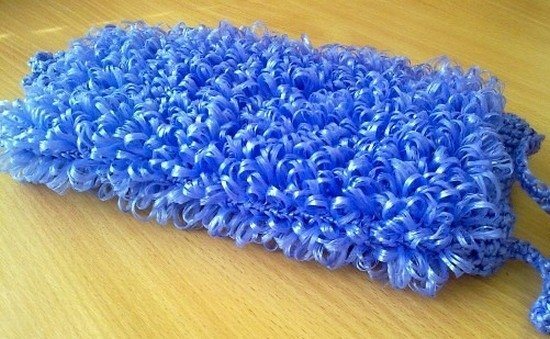
- At the beginning of the work, the threads (if there are several of them) are folded together and a chain of air loops is knitted from them. If the width of the finished product is planned to be about 10cm, then you need to knit a chain about 20cm long. That is, cast on 24-30 air loops.
- We connect the finished chain into a ring using a connecting loop, and then we tie the resulting ring with single crochets. We knit 5 rows.
- Further knitting is done using double crochets with elongated loops. Here's how to knit elongated stitches:
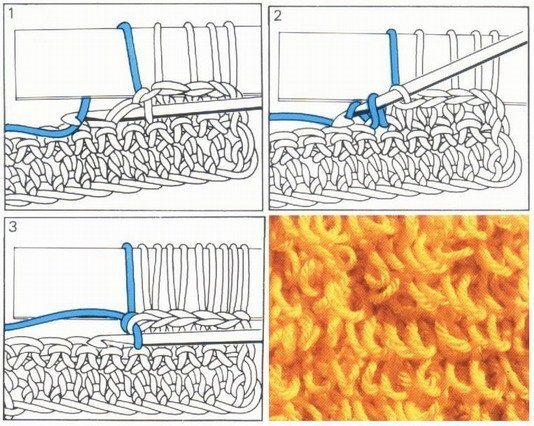
- The thread is caught by the hook;
- The hook is brought into the loop of the previous row;
- The working thread is grabbed from both sides so that a loop is formed on the thumb;
- Threads are pulled through the loop of this row and the loop is thrown off the finger. There should be four loops left on the hook;
- Now the working thread is grabbed by the hook and pulled through two loops;
- The working thread is grabbed again and pulled through the remaining two loops that remain on the hook;
- We knit rows of stitches with elongated loops, without changes, so much so that it is convenient to use a washcloth.
- Having reached this length, we again knit 5 rows with regular single crochets and finish knitting.
- In the last stage, we tie two strips along the width of the washcloth handles and tie them to the main part of the washcloth. The washcloth is ready.
Crocheting a washcloth with elongated loops
How to crochet a washcloth, diagram with elongated loops:
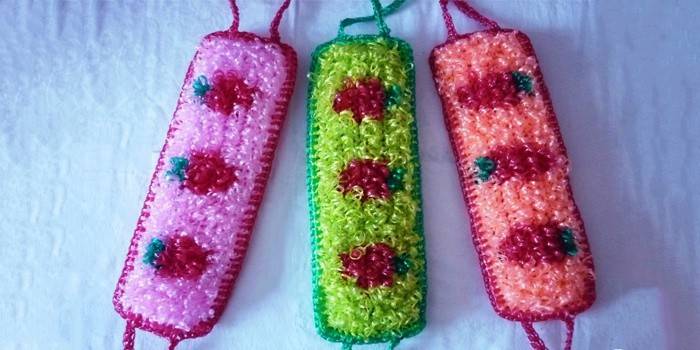
- A series of air loops are knitted and closed into a ring. The size of the ring determines the size of the washcloth in the future. The average number of loops is 40.
- Knit 7 rows single crochet.
- On the eighth row, elongated loops are knitted. Watch the knitting carefully so that the elongated loops remain behind the working fabric.
- You determine the height of the weave of the washcloth yourself.
- Completion of work: a couple of chains of air loops, then connect them into a ring. Knit the edge of the fabric. The created chains are the handles of the product. Make the length whatever you find most comfortable.
- The finished product is turned inside out.
- Your washcloth is ready, but you need to wash it before use. If you want the washcloth to become softer, pour boiling water over it.
Threads for knitting washcloths
The best option in choosing threads would be polypropylene thread - twine, but not too thick. A polypropylene washcloth works best with twine, similar to a thin ribbon. It's easier to knit with a single thread. Such a washcloth will not be voluminous enough. One washcloth takes an average of 300 meters of thread. When purchasing material, purchase skeins of thread with a reserve to avoid wasting time searching for suitable colors and density. You can buy polypropylene twine in handicraft or hardware stores.
What crochet to knit
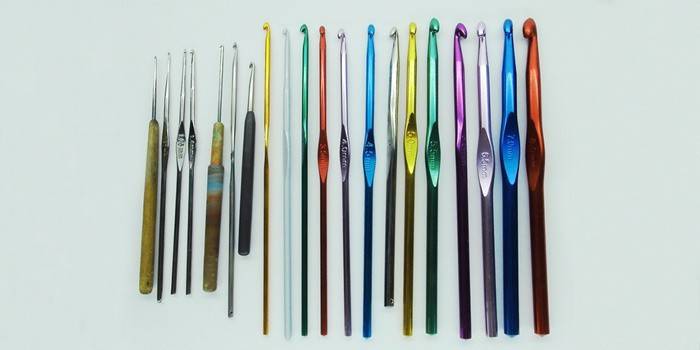
Comfortable knitting of washcloths depends on the ease of control of the main tool - a crochet hook. Decorative openwork knitting requires a thin “base”. The weaving is somewhat harsh, so it is worth remembering that you need to knit two threads for a bulky household item. It will be best if you select a hook of medium thickness (No. 4) and with a smooth head, otherwise the fibrous thread will break during weaving.
How to knit elongated loops
The first step on the path to how to crochet washcloths for beginners should be preliminary training. A little training will help you master the knitting method for its further use. Instructions on how to crochet elongated loops:
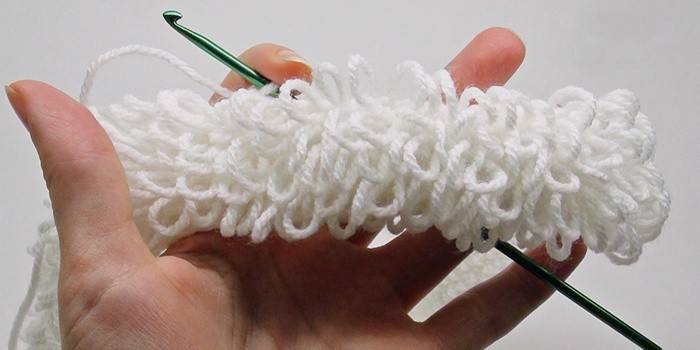
- We collect a chain of air loops.
- We knit 3 rows of single crochet.
- We create an air loop with a crochet hook, then a single crochet.
- We insert the tool into the previous row and make a loop.
- Using your thumb, we grab the working twine from below and make a large ring.
- We insert the tool into the same loop of the base.
- We grab the twine, pull it through, grab it again and pull it through three loops.
- Repeat until the entire knitting fabric is covered in shaggy areas.
How to crochet a washcloth
A beautiful bathroom accessory can be created not only with the help of twine threads. A colorful and bright washcloth is also knitted with thick nylon, sisal, and linen threads. For professional craftswomen this is a simple task. It will be more difficult for beginners, but step-by-step crochet for beginners will reveal all the intricacies of this delicate matter.
To knit such a product, sisal or flax threads are used. Nylon will create excessive rigidity for a product of this type. Crocheting a mitten is easier than knitting. There is no painstaking work involved in knitting the thumb. The mitten is knitted like this:
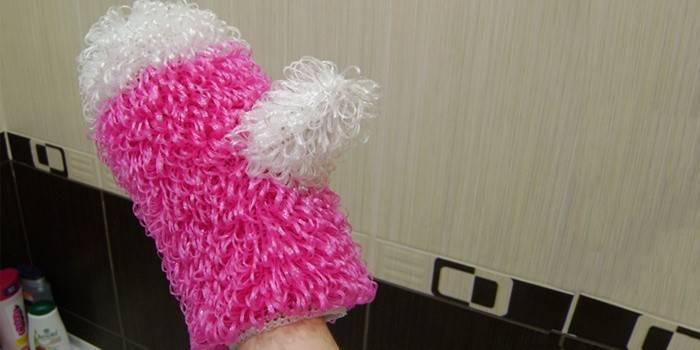
- Set of 30 air loops. If the mitten is for a small hand - 25.
- We knit the fabric in circular rows with a single crochet. Moving on to the next row, we knit 1 chain stitch. We determine the length of the canvas ourselves.
- When the required knitting length has been reached, we begin connecting the upper parts of the mitten. To do this, the upper and lower columns are knitted together and secured.
- After sewing all the parts, cut the thread. Your cleanliness assistant is ready.
Do you like to visit a Turkish or Russian bath? Prepare a practical accessory! The following materials are suitable for knitting bath accessories: linen, sisal, ramie, loofah, bast. The design can be chosen in different ways: round, very shaggy, mitten-shaped - all to your taste. To make a simple round bath accessory, you need:
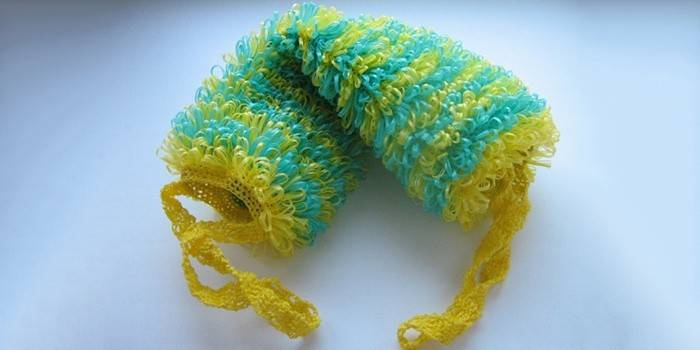
- Crochet 7 loops and close into a ring.
- Knit in single crochets in a circle.
- The diameter of the product will increase. When it reaches 17-20 cm, start cutting through each row.
- Knit 5 rows in this manner. You should now have a knitted “cup”.
- Place a piece of round foam inside and attach a handle. Decorate if desired.
A very easy option that even a beginner can master. Use colorful soft linen threads to avoid damaging your baby's skin. Cast on 50 chain stitches, knit single crochet, do not break the thread. The ribbon is rolled into a ball: the short edge of the ribbon is placed on top of the long one. The long end of the ribbon is inserted into the resulting ring, after which both ends of the ribbon are stitched.
A bathhouse without a linden sponge is not a bathhouse
In Rus', concepts such as health and beauty were closely associated with visiting the bathhouse. It was in it that people rejuvenated, rested, and, in modern terms, freed themselves from negative emotions and stress. What did they wash with? Of course, you already guessed it: linden washcloths.
The strongest bast fibers from linden trees, both old and young, were very widely used in everyday human activities. If we talk about bast fishing, then for it they removed the bark mainly from large trees. Longitudinal cuts were made on both sides of the trunks. Then, using a wooden wedge, two half-cylinder troughs were separated from the trunks. This removed bark was called bast, most of which was used for making bast.
Soaked bast fibers, which were tied into bundles, instantly turned into that same linden bath sponge, so familiar to any modern person.
Crochet washcloth, digest
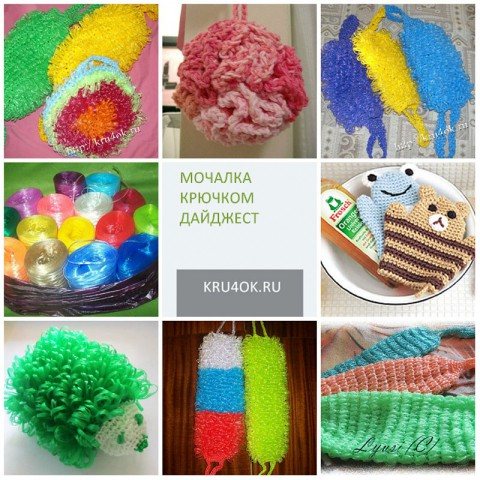
A crocheted washcloth can be crocheted from different threads: cotton, polyester, but most often washcloths are crocheted from polypropylene yarn. Such washcloths last longer, dry quickly, are bright, whip gel or soap into foam well, and are inexpensive.
Polypropylene threads can be purchased at the market, hardware store or craft store. Of course, ready-made washcloths are sold on the same market, but if you know how to crochet yourself, then why overpay. One washcloth with elongated loops takes about half a skein, and a skein of thread costs no more than 50 rubles.
Yarn for washcloths with elongated loops:
- “The Needlewoman”, produced by the Pekhorsk factory. Yarn composition: polypropylene-100%. Thread length: 200 m. Skein weight: 50 g.
- “For the soul and soul”, manufacturer: Hostess-Needlewoman. Yarn composition: Polypropylene 100%. Thread length: 250 m. Skein weight: 50 g.
- “Craftswoman”, Skein weight: 50 g. Thread length: 200 m. Composition: 100% polypropylene. Manufacturer: Russia.
- ADELIA "RAFFIA" . Weight, g: 50. Thread length, m: 200. Composition: 100% polypropylene.
- Just nameless yarn in bobbins for knitting washcloths.
Often a piece of foam rubber is inserted inside ready-made washcloths. Why do they do this? It’s just that the polypropylene washcloth itself does not create much foam from the shower gel, but with foam rubber any soap base foams perfectly. Moreover, it is more economical. More foam means less gel or soap is consumed.
How to choose threads for knitting washcloths with elongated loops?
Threads come in different thicknesses. The thicker the thread, the tougher the finished washcloth will be. Select threads of such thickness that it is convenient to use them for crocheting No. 3-4. Although the most delicate and soft washcloths are crocheted No. 2, i.e. thin threads. Some people like washcloths that are harder and denser, while others like them softer.
Buy bright threads to match your bath accessories. For children, it is better to knit a washcloth from thin threads in the shape of a mitten or a funny animal.
Before the first use, be sure to keep the washcloth in boiling water for 5-7 minutes, the washcloth becomes pleasant to the body and lathers well.
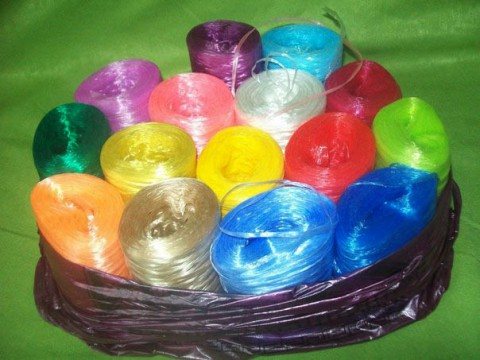
What shape should I knit a washcloth with elongated loops?
A washcloth with elongated polypropylene loops can be knitted in the form of a pipe in a circle. It is convenient to insert foam rubber into such a washcloth.
- You can knit a flat rectangular washcloth according to the usual pattern using single crochets (only every third row is knitted with elongated loops):
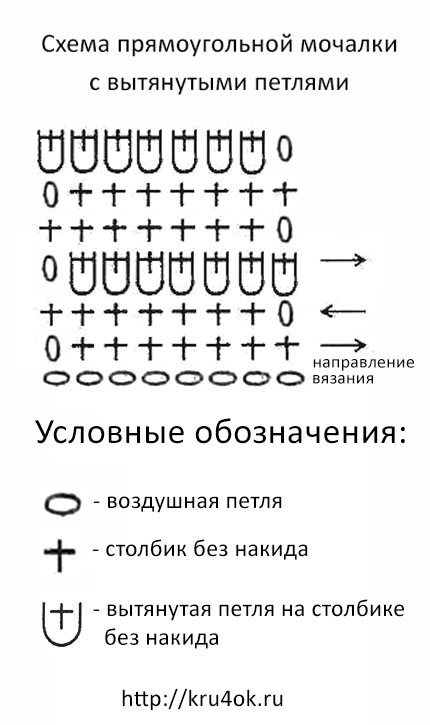
- The crocheted washcloth can be oval-shaped (in this case, every third row is also knitted with elongated loops):
- A washcloth can be crocheted in the form of a mitten with or without elongated loops:
- Round washcloth (do not forget to knit every 2 or 3 rows with elongated loops):
- A washcloth for a child can be crocheted in the shape of any toy with elongated loops.
There is one more nuance: the longer the elongated loops, the softer the washcloth.
How to knit elongated loops:
If you have never knitted with elongated loops, then you should first try to knit a sample from simple threads in order to practice and work out the tightness of the knitting. The fact is that you need to knit tightly with long loops, i.e. Tighten each loop with columns so that the fabric is not loose. It will be especially difficult for beginners to immediately knit elongated loops from polypropylene threads.
Knitting patterns for elongated loops (choose the one that most understands you):
Knitting elongated loops on a ruler:
Body washcloth: how to choose the best?
A body washcloth is not just a cheap thing that mixes foam from shower gel and helps wash away dust, sweat and dirt from the body. With the right approach to choosing a body washcloth, it is a massager, a scrubber that provides high-quality peeling of the body skin and at the same time effectively solves the problem of ingrown hair, cellulite crust and “pimples” on the skin (hyperkeratosis or keratosis pilaris). Overall, a good loofah, chosen wisely, is a toner and simply your skin's best friend!
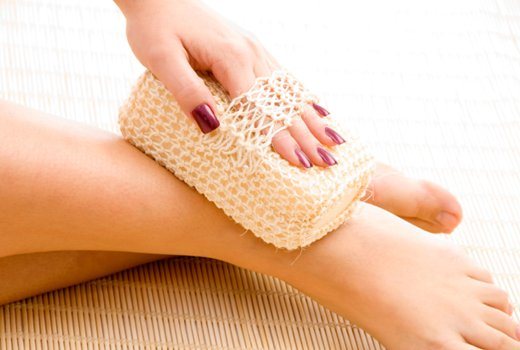
Natural body washcloths are the most popular class of bath accessories 44056
Our skin: problems will be prevented by the best body wash
In order to evaluate the role of this accessory in caring for the body’s skin, one should take into account the structural features of the body’s skin. The skin is our largest organ - it takes up approximately 15% of the total body weight and performs several important functions, including thermoregulation; protection from external damage by biological, chemical and physical “aggressors”. The skin also prevents excess moisture loss. Therefore, effective care of this largest organ is essential to maintain the body's skin functions properly. However, body skin problems tend to receive less attention - care is mainly concentrated on the face. This detrimental approach results in the skin on the body losing its presentable appearance earlier and aging faster.
In terms of physiology, structure and function, the skin on the face and body has similar characteristics. However, this is not entirely true: there are differences in the thickness of the epidermis, the speed of cellular metabolism and the activity of the sebaceous glands. The skin consists of two main layers - the epidermis and dermis, which have a layer of small fat cells. The epidermis is thinner and similar in structure to a brick wall. Keratinocytes, the predominant type of epidermal cells, synthesize the protein keratin - it strengthens the skin and helps protect it from mechanical damage. The epidermis also helps maintain adequate levels of skin hydration, skin plasticity through the secretion of natural moisturizing factor (NMF), and lipids such as cholesterol, fatty acids, and ceramides. In addition, the slightly acidic environment (pH 4 to 5.5) of the epidermis provides an additional effective barrier against microbial damage.
The dermis lies beneath the epidermis. Its subcutaneous layer consists of adipocytes, fibroblasts and immune cells of macrophages, as well as an extracellular matrix, which collectively includes molecules of collagen, elastin and glycosaminoglycans - they together provide structural support for the epidermis, attract and hold water molecules inside. This allows the epidermis to remain hydrated despite daily water loss, a phenomenon known as transepidermal water loss (TEWL). If the dermis is damaged or insufficiently toned, restoration of water balance fails. As a result, the epidermis loses its protective barrier function, which leads to a deterioration in the appearance of the body's skin, its dryness and even the development of hyperkeratosis.
The epidermis on the body, as a rule, is thicker: the maximum is achieved in the buttocks area - 96.5 microns (if compared with the face, then this figure fluctuates within 5 microns). An increase in the thickness of the skin epidermis on the body is associated with various types of hyperkeratosis, which, as a result, increases the risk of proliferation of pathogenic bacteria. The metabolism of body skin cells is also different - it is more “sluggish”. This affects the skin's natural ability to exfoliate, causing it to become dry. Dead cells of the stratum corneum thus accumulate on the surface, blocking the growth of new healthy cells from the lower layers. Also, due to the limited number of sebaceous glands, sebum production is significantly reduced. (The maximum concentration of sebaceous glands is usually found on the scalp and facial skin - up to 900 glands per 1 square centimeter). Sebum is important because it contains lipids such as cholesterol, fatty acids, squalene, waxes, diglyceride esters and triglycerides. One of their main functions is to maintain a sufficient level of skin hydration and protect it. Thus, the skin on the body is more susceptible to dryness than on the face. Therefore, it not only needs to be additionally moisturized with creams and lotions, but first of all, it is important to effectively and regularly exfoliate the skin on the entire body. And it’s not a scrub that will help you do this, but a fairly hard body washcloth.
Body washcloths: natural and synthetic
It’s not the same shower without a washcloth! 44775
Types of body washcloths: review and reviews
Since this accessory should give our body as many benefits as possible, it is worth choosing the most comfortable shape. If a back massage is important to you, a body washcloth with handles will provide it best of all; if you want to fight cellulite, give preference to hard accessories in the form of mittens, and for a thorough exfoliation of the whole body, perhaps a washcloth in the form of a towel or glove will be optimal . Square washcloths - natural or synthetic - are considered universal. Now let's figure out which body washcloth is better - natural or synthetic? Hint: depends on what you expect from it.
Natural body washes
Natural body washcloths are the most extensive and, perhaps, the most popular class of bath accessories. Our most popular products are probably body washcloths made from loofah , a plant related to pumpkin. Loofah sponges have a fairly average exfoliating, massage and anti-cellulite effect - the mesh made from this fiber is too smooth. To feel the massage effect of such a washcloth, you should make a lot of physical effort. At the same time, these are fairly inexpensive and durable body washcloths that serve for a long time and faithfully, the main thing is not to keep them in a damp place so that fungus does not grow there.
Body washcloths knitted from ramie fiber – a plant related to nettle – will be stiffer. They provide a fairly good massage and anti-cellulite effect, and at the same time they are quite gentle on the skin, gently polishing but without scratching it. Natural ramie washcloths cleanse the skin well and stimulate blood circulation. However, they are more expensive than a loofah, and can also break quickly (the service life depends) on the manufacturer.
You can knit a good washcloth – natural or synthetic – yourself. 44153
Natural body washcloths also include accessories made from sisal , a fiber obtained from agave leaves. They can be knitted in the form of mittens or woven with a brush, which, by the way, cleans out dirt quite well. Agave fibers will be tougher than loofah, so this type of washcloth is more suitable for comprehensive body skin care - it provides high-quality peeling, massages well, and gives enough foam. Alas, such products are quite expensive, but at the same time they are short-lived: when rubbed, the sisal pile constantly falls out, also clogging the drain in the shower.
Cellulose washcloths are a class of ecological products that are more suitable for facial care than body care: they have a porous structure that is too delicate to provide massage or exfoliation.
Sponges - sea sponges - are perhaps the very first body wash that was ever used by humans. Alas, they do not break up cellulite, do not exfoliate the skin and practically do not massage it. In addition, sea sponges very quickly become polluted and turn into a breeding ground for all kinds of bacteria. The disadvantages of natural sponges are also their high price and short service life.
Synthetic body washcloths
Truly, the hardest body washcloths are synthetic ones . Real monsters, cellulite killers that foam perfectly, massage and exfoliate the skin - these are parallelepipeds made of polymer bristles, inside which foam rubber is hidden for optimal foaming. They massage, exfoliate, wash away dirt, and even provide some lymphatic drainage effect to help combat puffiness. However, for people with extremely sensitive skin, a large number of moles, as well as patients with atopic dermatitis, psoriasis or eczema, such a washcloth is most likely not suitable.
Japanese body washcloths are the so-called washcloths-towels, the know-how of the inhabitants of the Land of the Rising Sun, made in the form of a canvas. As a rule, they are made from nylon threads of various weaves, which provides some massage effect. This washcloth can be rolled up in any way, which helps to wash any areas on the body. Japanese body washcloths can vary in degree of hardness and can be “upgraded” with various additives for gommage.
Review of Japanese washcloths 44468
Foam sponges are the cheapest type of synthetic sponges. As a rule, they provide only rich foam, without providing any skin care, although there are versions that are similar in rigidity to car wash sponges - they massage the skin quite well. Without exception, all foam sponges tear very quickly.
Whiskers - perhaps they are at the bottom of the ranking of all bathroom accessories. A thin nylon mesh will indeed, to some extent, help prevent ingrown hairs, but the main purpose of such an item is to whip up foam in the bath.
Body washcloth: which is better?
Frankly speaking, it’s synthetic. Firstly, such washcloths are much more hygienic: the polymer base, even with prolonged use, will not become a breeding ground for pathogenic microorganisms (although dampness should not be allowed). Secondly, synthetics are much more durable: such a washcloth will last for years, and will not crumble when used and clog the drain in the bathroom. Well, and most importantly, they are safer than natural washcloths: the synthetic pile does not contain microchips, it is smooth and cannot damage the skin, as happens, for example, when washing with scratchy sisal. At the same time, the smooth surface of synthetic fibers does not affect their rigidity in any way: they are very elastic, so the massage effect of a skillfully selected synthetic washcloth will be higher - as a massager that tones the skin, such an accessory is much more valuable than natural washcloths for the body of various configurations. However, not all synthetic accessories are identical in this regard. For example, Japanese body washcloths exfoliate the skin quite well, but the massage effect when using them will be very mediocre.
How to choose a washcloth 44471
Crocheted washcloth with elongated loops, the work of our readers
Our master classes and video lessons will tell you how to crochet a washcloth.
Crocheting washcloths, master class!
The author of the description is Noskova Nadezhda. Nadezhda writes that knitting is her hobby! Today she will tell you how to crochet a washcloth.
Crochet washcloth, step by step description
First we knit 40-45 chain stitches and connect them into a circle.
We tie 5 rows with single crochets, then begin to pull out the loops (see photo).
After pulling, the loops must be secured with an air loop (see photo), otherwise they will crawl out to the wrong side and the washcloth will turn out flabby.
We knit the length of the washcloth individually (expecting that it will stretch during use). We finish by tying with single crochet chain loops and tying the handles. A skein of thread costs 25 rubles, enough for 2 washcloths. And cheap and beautiful!
You will need yarn for knitting washcloths and a size 4 hook.
Bast washcloth and delicate skin
If you are a fan of rich foam, soft, gentle washing, you are unlikely to like this natural washcloth. It will also not cause great delight among small children.
A bast for those who like to rub their skin until it’s red and squeaky clean.
If you have been actively sunbathing and have acquired an incomparable bronze skin color, do not use a bast washcloth - use fluffy soft sponges. And when the turn of autumn and winter cold comes, then you can use a bast washcloth to disperse the blood!
To combat the eternal female problem (cellulite), there is no better option than a bast washcloth. Natural rigidity is an ally in breaking up unnecessary deposits on the hips.
This is the bast washcloth that Mother Nature and the beautiful linden gave us. If you don't believe me, try it yourself! Good luck to you!
Not a single resident of the outback will waste his time in thought when it comes to choosing a new washcloth for the bath. Well, of course, it’s fake, what else? He will not be “turned away” by the multi-colored synthetic accessories for baths and baths, so beautifully laid out on store shelves. He will proudly walk by, knowing that the linden washcloth is what he, a person who truly cares about his health, needs.
A whole story awaits you if you ask him about the properties of this much-needed thing that will accompany you when going to the bathhouse. And not only in the bathhouse, in the bathtub and sauna it will take its well-deserved place of honor. But you still read the story about the linden loofah so you can tell it to your family and friends.
Click on photo to enlarge
Linden sponges were brought from environmentally friendly Nizhny Novgorod forests. Natural linden sponges are medicinal and, when steamed, release phytoncides that have a beneficial effect on the upper respiratory tract. The most important thing is that the linden washcloth has a natural bath aroma.
- the length of the linden sponge is 80-90 cm.
- 1 bundle = 10 pcs.
Crochet washcloth with elongated loops, interesting ideas from the Internet
The washcloth is crocheted No. 2; it took half a skein of thread.
This washcloth is crocheted from propylene thread in 2 folds, with crochet number 5. It is knitted equally on both sides, with a “Fringe” pattern or elongated loops.
A washcloth-mitten, just like a regular washcloth, is knitted simply: 1 row of single crochets, 1 row of elongated loops.
Another option for a washcloth with elongated loops.
Materials: – polypropylene threads of different colors; – crochet hook (select the size depending on the desired density of the washcloth - the smaller the number, the denser the product will be, and vice versa).
Author Irina Kachukova. For knitting you will need: yarn “Housewife - a needlewoman for the soul and soul” 50g, 100% polyamide, package 10x50g and a hook.
Crochet washcloth video tutorials
Crocheted washcloth toy “Clean Bear”
The toy has eyes, a nose and ears. On one side it is shaggy, and on the other side it is smooth and has a comfortable handle.
To knit a washcloth you will need:
- polypropylene threads of three colors: any main color, black and white for the eyes
- scissors
- needle
- hook No. 2.5, hard so as not to bend
Part 1 The video should load here, please wait or refresh the page.
Part 2 The video should load here, please wait or refresh the page.
Crochet round washcloth for beginners
We will need: yarn; hook number 3.
The video should load here, please wait or refresh the page.
Crocheted washcloth toy “Funny hedgehog”
- polypropylene thread 70-80 g primary color
- polypropylene thread black, white, green and red
- hooks No. 2.7 and 4.5
- darning needle with wide eye
- scissors
- template to make a flower
The video should load here, please wait or refresh the page.
The video should load here, please wait or refresh the page.
